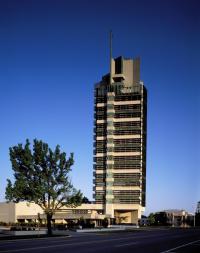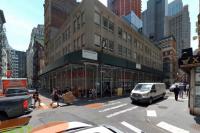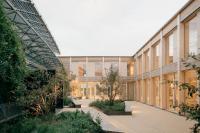College of Architecture and Civil Engineering
Shenzhen, 中国
The college building accommodates the departments of architecture, planning and civil engineering, as well as an architectural design institute, a press house for World Architectural Review, and other research institutes. The design strives to create pure and transcendental architectural spaces _ a locus experience that finds spiritual affinity within an university setting.
The teaching, research and design institute activities are separately housed in three distinct building volumes, complementing one another both in term of floor plan and space. These three structures are connected by open loggia, bridges and terraces. These outdoor spaces are open toward different directions, allowing outsiders to see through and framing views from inside. These are the most active elements in the compound. Besides communication, these places are also used for looking out, relaxing and socializing.
One important idea in design is to create visual dialogues among different parts of the building blocks. Each block has a main open fa_ade that allows such dialogues. Generous terraces of the teaching block contrapose the curving wall of the design institute and lush foliage beyond to the east; large glass windows at the west end of the design institute overlooks the inner court of the teaching block; open corridors and terraces to the south and north also have similar visual contacts.
The college building accommodates the departments of architecture, planning and civil engineering, as well as an architectural design institute, a press house for World Architectural Review, and other research institutes. The design strives to create pure and transcendental architectural spaces _ a locus experience that finds spiritual affinity within an university setting.
The teaching, research and design institute activities are separately housed in three distinct building volumes, complementing one another both in term of floor plan and space. These three structures are connected by open loggia, bridges and terraces. These outdoor spaces are open toward different directions, allowing outsiders to see through and framing views from inside. These are the most active elements in the compound. Besides communication, these places are also used for looking out, relaxing and socializing.
One important idea in design is to create visual dialogues among different parts of the building blocks. Each block has a main open fa_ade that allows such dialogues. Generous terraces of the teaching block contrapose the curving wall of the design institute and lush foliage beyond to the east; large glass windows at the west end of the design institute overlooks the inner court of the teaching block; open corridors and terraces to the south and north also have similar visual contacts.
Project Name: College of Architecture and Civil Engineering
Location: Shenzhen University, Shenzhen
Client: Shenzhen University
Architect: Gong Wei Min, Lu Yang, Tian Chenxin, Wang Jian, Dong Jianhui
Structure and Material: concrete, brick
Building Area: 12700 sq. meters
Cost: 25 Million RMB
Design Period: 1999_2000
Construction Period:2001_2003














